Search the Special Collections and Archives Portal
Search Results
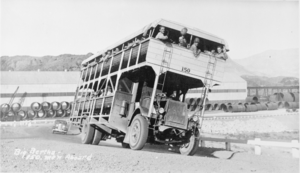
Film transparency of workers being trucked to Hoover Dam construction site, circa 1930-1935
Date
1930 to 1935
Archival Collection
Description
A picture of a truck known as "Big Bertha," carrying 150 workers to the Hoover Dam work site.
Image

Film strip of Boulder City or Hoover Dam construction, image 006: photographic print
Date
1934-05-29
Archival Collection
Description
This photograph has three images. The first one (0272_0026) is a picture of the first bucket of concrete poured in Boulder Dam, June 6, 1933. The handwritten inscription reads, "The first bucket was 'grout' (cement and water) which was spread over surface of pour with steel brooms. All loose rocks have been pried out, and all cracks have been pumped with grout until filled. Some has taken a week of continuously pumping night and day. Each from and pour is supervised by government selected men." The second one (0272_0027) reads, "Excavation for foundation three hundred feet below river bed down to bedrock." The picture is looking upstream, excavation for dam foundation, Boulder Dam photo provided by the Bureau of Reclamation. It also says, "Seen from lookout point above. Trucks struggling up and down the steep grade, reminds you of ants as they attack this giant job. I often wondered where did they put all this dirt and rubble? Brakes were soon worn out and never replaced. Trucks were geared down real low, but you still got a thrill, going downhill. x-marks trussel for rail that will bring concrete from lower mixing plant around the bend where the mts. end in a gentle slope." written as a handwritten inscription. The third one (0272_0028) reads, "Drilling of walls to clean up and to blast off loose slabs on upstream canyon walls. These men climb hand over hand at end of shift, and slide down to work. The art of keeping your balance in a bos'n chair is picked up in a hurry at heights like this. I saw a miner hand a 90 lb. Hammer of his shoulder and climb hand over hand 75 ft. up, until he got past the overhang before he could touch the canyon wall with his feet. It was a side show," written as a handwritten inscription.
Image

Film strip of Boulder City or Hoover Dam construction, image 009: photographic print
Date
1930 (year approximate) to 1939 (year approximate)
Archival Collection
Description
This photograph has three images. The first one (0272_0043) has a handwritten inscription that reads, "Government hi-line setting 30' pipe on tracks in working tunnel. Note size of men." The second one (0272_0044) reads, "Placing pipe in penstock tunnels. Spider stays in place until next pipe is connected - still on the rails." The third image (0272_0045 and 0040) gives a good view of workmen getting these two locations ready to pour. It reads, "The carpenters leveling the panels and installing the vertical keys - plumbers installing cooling pipe - clean-up crew with their air and water hose sandblasting top of cement for better bonding. Must be a rush job for grave-yard tonite." "Form raisers, with 'A' frames in place. Prying the specially made panel, to replace it with regular one you see lying in pour below." "Gov. inspectors. They check every form of work that is done on the dam. Then sign the OK to pour. My job, once, was to see that all works were OK." "I liked the carefree and daring of the form raisers. Also had a friend in the crew. I got a lot of ribbing from them about my easy job. After two weeks of trying I at last got a transfer. Later felt Tommy sorry. But could walk the 2x12 with both shoulders slung with chain jacks and block & tackle. Or drop down on a up-stream panel, hook my safety belt and twist out as many 'she-bolts' as the best." "It was fearful hanging on your safety belt, on the upstream face of the dam. Out of sight, all you could see was a lot of down - hang on for dear life - when the crew starts prying the panel loose and you & panel are swinging on the jacks - loved it."
Image

Film strip of Boulder City or Hoover Dam construction, image 017: photographic print
Date
1930 (year approximate) to 1939 (year approximate)
Archival Collection
Description
This photograph has three images. The first one (0272_0084) reads, "Top of dam about one form wide - everyone getting in each other's way" (duplicate of Image 0272_0016). The second image (0272_0085) reads, "Getting higher and more enormous. Can you see what's swinging on end of No.7 line?" Refers to the arrow at the top right of photo. "(3) tunnels drilled for penstocks that divert water to turbines. So much to tell about, that's shown in this pic. You can see where the turbines will set. The (slot) in middle of dam indicates how much of the dam has been cooled. Notice how dam curves into canyon walls - to brace against weight that will build up behind it." The third image (0272_0086) shows an early view of the enormous amount of excavating being done and tailings to be moved. An inscription reads "Pouring cement on any part of the dam has not begun, only the diversion tunnels and tracks for head tower and tail tower that hi-lines across the channel are connected to" (referring to the arrow at top of photo). The inscription continues "(x) Reeve fell down this tunnel but was cemented at that time. On the dam I never heard anyone being hurt with falling rock. But - most injuries and fatalities occurred building roads to the dam and at the location of dam. No men have been covered up and left in the cement. Nothing but the purest cement went into the construction of dam, maybe a piece of metal if it wasn't oily. About men being buried in the dam is a misconception (sic). Some have been covered up with cement when the bucked dumped out of control, but the men were rushed to first aid and washed off, and treated, but very few injuries."
Image
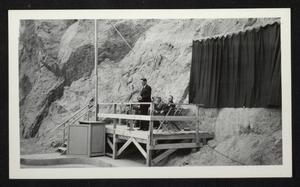
Photograph of the unveiling of the memorial plaque, Hoover Dam, September 30, 1935
Date
1935-09-30
Archival Collection
Description
An image of a man standing atop a wooden platform as he presents a speech for the unveiling of the memorial plaque at Boulder Dam. Positioned behind the man are seated spectators of the event, as well as the curtain-covered memorial plaque.
Image
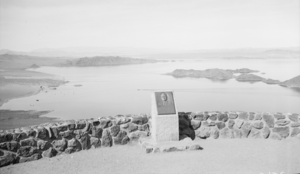
Film transparency showing dedication plaque at Hoover Dam, circa 1930s
Date
1931 to 1936
Archival Collection
Description
An image of a plaque dedicated to Elwood Mead, Commissioner of the Bureau of Reclamation Department of the Interior, 1924-1936.
Image
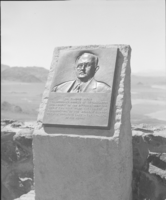
Film transparency of a dedication plaque at Hoover Dam, circa late 1930s
Date
1936 to 1939
Archival Collection
Description
A close up view of a plaque dedicated to Elwood Mead, Commissioner of the Bureau of Reclamation Department of the Interior, 1924-1936.
Image

Photograph of barge on Colorado River, Hoover Dam, circa 1930-1935
Date
1930 to 1935
Archival Collection
Description
An image of an automobile parked next to a barge on the Colorado River in Black Canyon at the Hoover (Boulder) Dam construction site.
Image

Film transparency of people at an observation point for Hoover Dam, September 19, 1931
Date
1931 to 1936
Archival Collection
Description
Description provided with image: "Minnie "Ma" Kennedy and Guy Edward "Whataman" Hudson's wedding at Observation Point, overlooking the Hoover Dam site, near Boulder City, Nevada Sept. 19, 1931. L-R: (far left) Ryland G. Taylor, one of Hudson's attorneys; Justice of the Peace Frank M. Ryan; Hudson, holding the license; Ma Kennedy; Mrs. Ryland G. Taylor (dark flowered dress); District Attorney Harley A. Harmon (hat in hand); Mrs. C. P. Squires (hat with feather); Mrs. E. W. Cragin; a reporter; P. L. Lacy, proprietor of Railroad pass store; G. E. "Bud" Bodell, police chief of Boulder City (extreme right). Tall man in very back is Mayor E. W. Cragin of Las Vegas."
Image
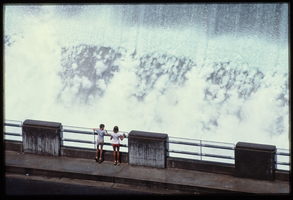
Children watch the overflow water in the Arizona spillway, looking west at Hoover Dam, Arizona: photographic slide
Date
1983-08
Archival Collection
Description
This series of photographs documents the historic water overflow at Hoover Dam as seen from the Arizona side of the dam. Taken in August of 1983, this overflow marked the first time the spillways were used during a flood. After initially being filled, the spillways were tested once in August of 1941.
Image
Pagination
Refine my results
Content Type
Creator or Contributor
Subject
Archival Collection
Digital Project
Resource Type
Year
Material Type
Place
Language
